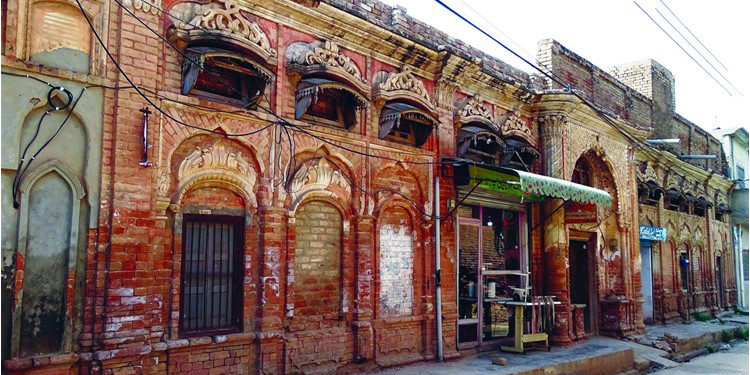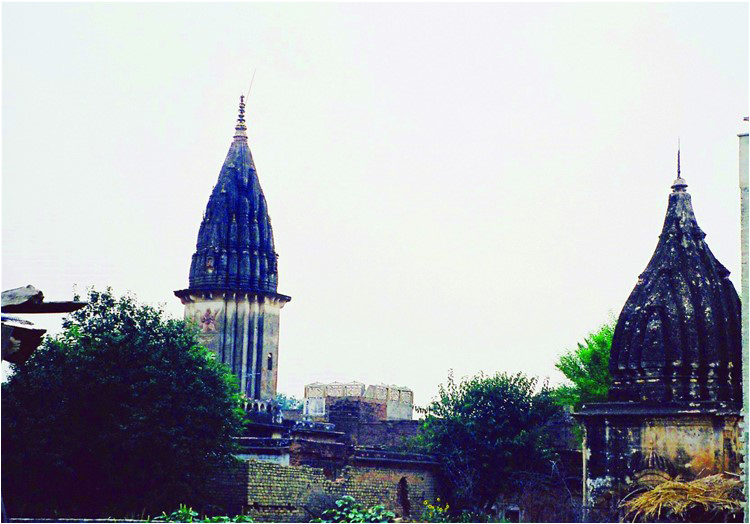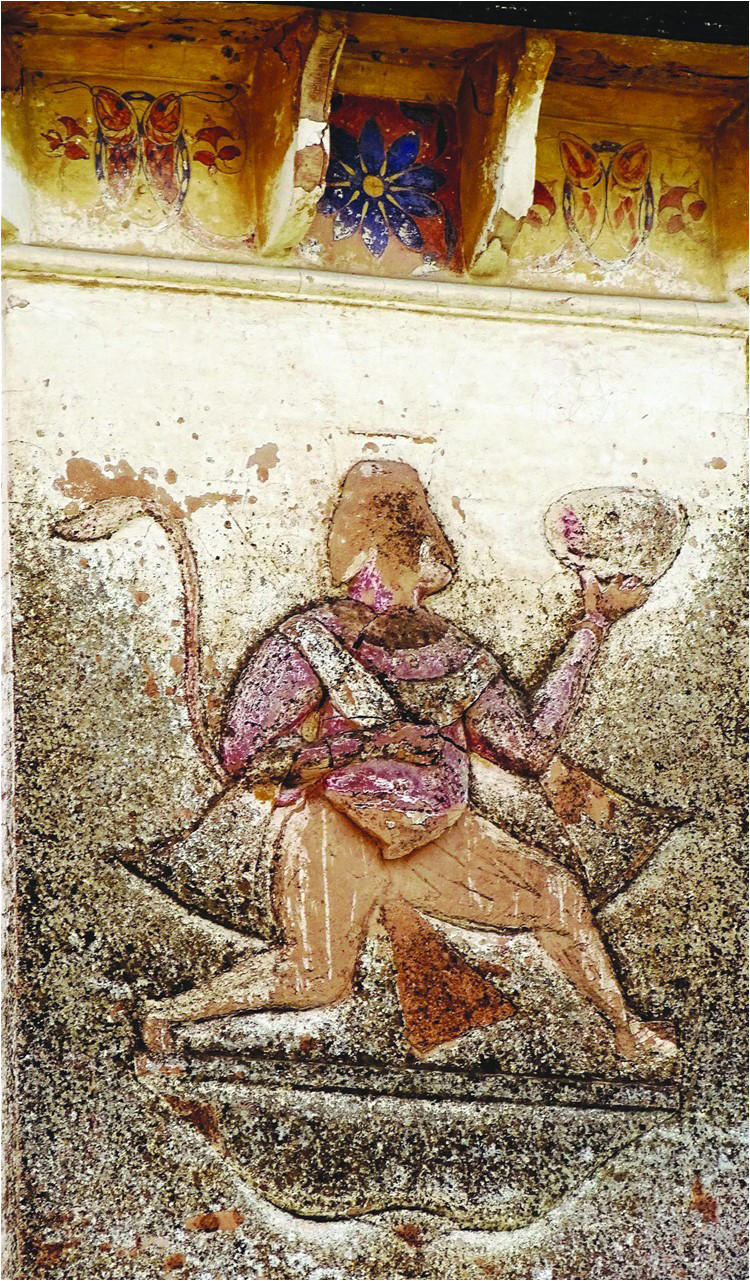
The Janj Ghar lies behind the Ram Das temple in Chaddran Mohalla of Bhaun Town of Punjab. It is one of the impressive structures of the colonial period in Bhaun.
Zulfiqar Ali Kalhoro
We are losing a historic building of Potohar with every passing day. In many of the towns in Potohar, the historic monuments are fast falling to pieces and the authorities concerned are least bothered to preserve them.
One such historic towns of Potohar is Bhaun, located about 11 km south of Chakwal town. It is believed that Bhaun was formerly known as Bhavan meaning “house”. It is famous for temples, gurdwaras, shrines, samadhis, and havelis with exquisite doors, amazing wooden balconies and mural paintings. Prior to the 1947 Partition of the Indian Subcontinent, Hindus predominantly inhabited this town. But later they migrated to India, while Muslims who had come from India to Pakistan took possession of the havelis, temples and mansions.
During my recent visit to Bhaun, to my utmost dismay some of buildings that I saw in 2004, 2006 and 2008 have lost their physical existence. A few are in ruins and the others have been completely rebuilt. Unfortunately the inscribed slabs have also been removed from some of the buildings or they have been whitewashed. When I first visited Bhaun in 2004, I saw the inscription on the historic Janj Ghar which read that the building was built by Bakramjit.
The Janj Ghar lies behind the Ram Das temple in Chaddran Mohalla. It is one of the impressive structures of the colonial period in Bhaun. The distinctive features of the Janj Ghar are the ornately carved doors, windows, ceilings, mural paintings and stuccowork. The main entrance of the buildings is noted for ornately carved wooden door, mural painting and stucco. Both stuccowork and paintings have now lost their original beauty.
In the past, Bhaun used to be a very important trade centre where Hindus controlled the business of the town and neighboring villages. They left behind a host of temples and havelis, having great architectural value, which were a blend of local and Kashmiri styles with very little ornamentation. These temples are different from those at Ketas and Malot that boast of the Kashmiri style and are lavishly ornamented.
Some of the temples at Bhaun are adorned with paintings, while some are very tall and can be easily spotted from a fair distance. There are at least 10 temples in and around the town, of which two have collapsed. Two temples located in Chaddran Mohalla date back to 1894 and are in shambles. One of the temples, which was built by Ram Das, is the most imposing one in Bhaun town. The facade of the temple is ornamented with the image of Lord Hanuman. A nearby temple also lies in pathetic condition and is a victim of neglect. It is feared that it may cave in if conservation measures are not taken in time by the authorities.

Another temple which is locally known as Madu Sain Lokan also lies in a deplorable condition. This temple has been turned into a cattle pen! The occupant has been using it as cattle pen since 2004 when I first visited the temple. Apart from the temples of Ram Das and Madu Sain Lokan, there used to be two temples at Madhu Wali Ban which I saw in 2004 and 2006. According to local people both caved in few years ago. One of them was very tall. Both the temples were adorned with paintings. On its exterior, panels were created on each side to depict a pair of fish, which is a special characteristic of the Vishnu temples and also Matysa incarnation of Vishnu. The traces of paintings on each of its sides were visible when I documented them in 2004.
There was another temple behind the government primary school No. 3. Though small in size, it was beautifully built but, like the temples discussed above, was in a poor condition. It also contained separate panels created for depicting a pair of fish on each of its sides. From inside, it was decorated with paintings, some of which depict Hanuman with his disciples. A closer look at the paintings revealed the repeated depiction of peacocks and parrots. On one of the panels, parrots were seen drinking water. On the same panel, one finds Hanuman sailing with his disciples. It was also interesting to find the illustration of the palm date tree that is a special feature of Muslim paintings. These temples also had floral designs.
Much like these temples, it is the case that the havelis and mansions belonging to the Sikh and Hindu communities still dominate the landscape of the town. Almost every narrow alley in the town boasts buildings of historical significance. One such building near the Qazian Wali Mosque, locally known as Marri, is noted for its elegant balconies and striking wooden carved doors. This three-story building is known to have been built by Rai Bahadur Sardar Jai Singh who worked as a contractor in Zahedan, Iran during the rule of Reza Shah Pahlavi I from 1925 to 1941. Marri was constructed during this period. It was most probably built in 1930.

Architecturally, the building is divided into three stories of which the ground floor used to function as the verandah with a row of richly carved columns running all around it. In front of the verandah existed the courtyard mainly used by women for dishwashing, laundry and drying grain. Men used it as a place for sleeping in dry weather. The first floor was reserved for junior members of the family and some visitors. The second floor was used by the senior members of the family or by married couples, while the third floor was occasionally used whenever there was a long spell of dry weather.
It had a pavilion for enjoying the evening breeze which was a peculiarity of Potohari havelis. Marri housed a total of 14 small and big rooms, some of which were discreetly decorated. The remarkable features of Marri are the wooden balconies, one each on the western and southern faces. The wooden doors are also ornately carved which reflected the opulence and aesthetics of the builder.
The expansion of new houses in Bhaun is devouring the cultural landscape of the town which needs to be controlled before we lose all the historic buildings. Due to this expansion, one has already lost two of the most impressive temples and some havelis of the Hindu and Sikh communities. The authorities concerned should declare the Old Bazaar of Bhaun town to be a ‘Heritage Street’ where lie the most magnificent mansions of Hindus and Sikhs. Some of the last remnants of Bhaun as it once was are the Marri of Rai Bahadur Sardar Jai Singh and the haveli of Nanak Chand.
_________________
 Dr. Zulfiqar Ali Kalhoro is an anthropologist and has authored 12 books: ‘Symbols in Stone: The Rock Art of Sindh’, ‘Perspectives on the art and architecture of Sindh’, ‘Memorial Stones: Tharparkar’ and ‘Archaeology, Religion and Art in Sindh’. He may be contacted at: zulfi04@hotmail.com
Dr. Zulfiqar Ali Kalhoro is an anthropologist and has authored 12 books: ‘Symbols in Stone: The Rock Art of Sindh’, ‘Perspectives on the art and architecture of Sindh’, ‘Memorial Stones: Tharparkar’ and ‘Archaeology, Religion and Art in Sindh’. He may be contacted at: zulfi04@hotmail.com
Courtesy: The Friday Times Lahore